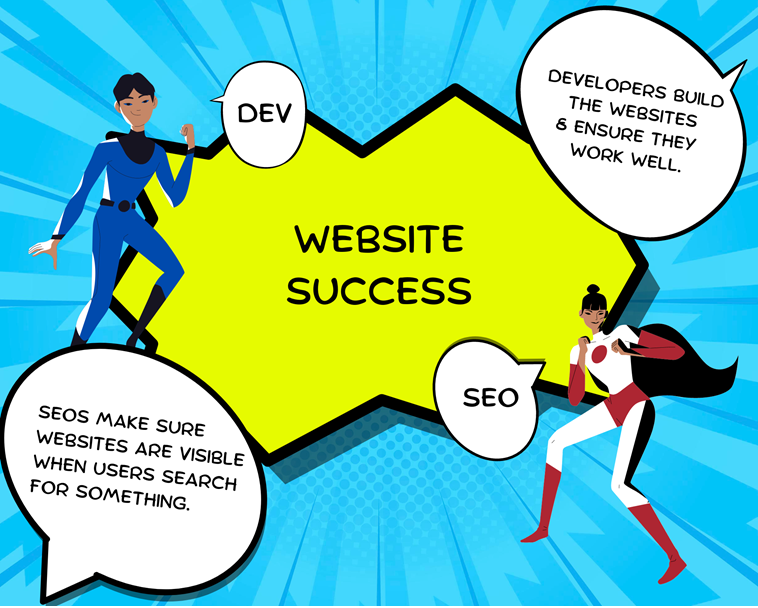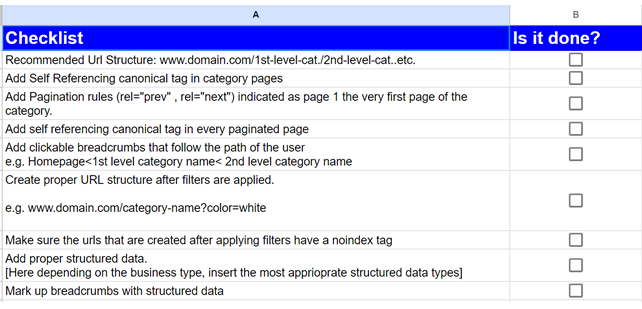 }
}
Bridging the SEO-Dev Gap: 5 Steps to Collaborative Success
Published 2024-04-15
Bridging the SEO-Dev gap is something we take seriously here at Sitebulb. So we asked Stevy Liakopoulou, SEO specialist at Search Magic, for her 5 steps to collaborative success between developers and SEOs.
SEOs and devs have to work together if we want SEO campaigns to bring results. And the reality is that if the technical foundation of the website is not working properly, no matter how authoritative the content you publish is, it will flop!
I communicate with developers all day long to make sure that prioritized fixes get done and everything works smoothly. Not only that, I learn from them too.
In this article, I’m going to share my roadmap to communicating effectively with devs and engineers to get those fixes done!
Contents:
- Building a foundation of understanding
- Speaking the same language
- Establishing channels for seamless communication
- Prioritize and delegate for SEO success
- Involve devs early in SEO implementation
- TL;DR recap
1. Build a foundation of understanding
The first step to bridging the SEO-dev gap is understanding each other's roles.
“SEOs and developers are like superhero teams with different powers, working together to make websites work and increase organic traffic.”

SEOs and devs can also educate one another. SEOs can learn how developers do their coding and discover “the why” behind their disagreements, while developers can learn why SEOs care about certain fixes. Sharing what we know helps us to work better together.
Teamwork makes the dream work!
2. Speak the same language
The number one priority for success is improving communication between SEOs and devs. Here are my top communication tips.
Ask questions and avoid using jargon
Using simple language helps everyone to understand the importance of a task and work together better. Here are some examples of how you can adapt your language to avoid jargon and make yourself better understood.
|
Instead of saying… |
Say… |
|
There are indexing issues |
There are problems with how search engines read our website |
|
Add structured data in product pages |
In every single product page add the Product Schema Markup in the HTML body. Make sure that in the code are included:
(Or even better, provide devs with the code snippet.) |
|
We have orphaned pages |
We have pages with no internal links pointing to them, making them difficult for users and search engines to discover and navigate |
|
These are render-blocking resources |
These are resources that delay rendering and user interaction, negatively impacting user experience and search engine performance |
If something is unclear, asking questions helps to avoid confusion. Encourage devs to ask SEO-related questions. This will help them to feel included, learn more about SEO, and understand your priorities better.
Share documentation and guidelines
Create and maintain documentation that outlines SEO best practices, technical requirements, and guidelines for developers to follow. This helps to ensure consistency and clarity in implementing SEO-related changes.
What documentation should cover:
- SEO best practices that developers need to be aware of when working on website projects for different types of pages.
- Technical requirements that impact SEO. This may include site speed optimization, responsive design, structured data markup, canonicalization, redirects, and handling of duplicate content.
- Any other notices that should be in mind when they do their work.
Tech SEO guidelines and checklist
Here’s an example of the kind of documentation I created for developers when we had to do a migration for a large e-commerce website with multiple categories and subcategories.
I provided guidelines on:
- The url structure of 1st, 2nd and 3rd level categories as well as product urls
- Hreflang attributes
- Canonicalization on every level of categories as well as product urls
- Pagination rules
- Breadcrumb rules
- Filters
- Structured data guidelines for categories of all levels, homepage, product urls
- Redirections from http to https, www vs non-www version, uppercase vs lowercase letters and non-trailing slash urls vs trailing slash urls.
- Paths for Disallow, as well as sitemaps in robots.txt file
- Sitemap structure
- Images
- Universal rules for the meta-data (page titles, meta description, H1) of product urls

Here is a template you can use yourself!
The outcome: During the creation of the new website in staging, I got only 2 questions in 3 months – that was my goal!
3. Establish channels for seamless communication
Talking often is really, really important
Frequent and open communication between teams is vital for our success. When we engage in transparent conversations, we encourage better understanding and alignment towards the business goals. Regular brainstorming and updates help us to address challenges quickly and ensure smoother workflows.
Set regular meetings & project check-ins
Try to avoid bombarding devs with tickets because this can easily become overwhelming and confusing in terms of priorities. A great idea is to schedule meetings once in a week to cover questions, ideas, progress or any other information that is important for the project.
Establishing a routine of regular meetings and project check-ins, between SEOs and developers, is a fantastic idea. These gatherings serve as touchpoints to assess progress, troubleshoot any issues, and brainstorm solutions collaboratively. Creating an environment where questions are welcomed and ideas freely shared ensures everyone feels involved and invested in our collective success.
Use tools like Slack, Trello, or Jira for project management
Try using simple tools like Slack or Trello to talk and manage projects better. With these tools, developers and SEOs alike can see what needs to be done and who's in charge of it.

4. Prioritize and delegate for SEO success
So you’ve done a crawl using your website audit tool of choice and exported a list of all the technical issues found on the website. Now ask yourself: Will each of these issues have the same effect on the website once they are fixed?
The answer is probably no!
The point is, how will a developer know from a great long list of issues which are the ones to focus on? So make sure you set priorities from high to low.
Sitebulb prioritizes all the issues it finds so you don’t have to. It also gives you easy-to-understand Hints and explanations. Try Sitebulb for free today

Benefits of prioritization:
- Faster improvements: Serious issues that affect the website functionality and have the biggest impact on performance are solved first.
- Efficient resources allocation: The team can focus on addressing high-priority issues that have the most significant impact on SEO before tackling lower-priority ones.
- Improved collaboration: Collaboration between developers and SEO teams is facilitated when priorities are clearly communicated.
When we work together, we can find opportunities, solve problems, and choose wisely to get good outcomes. This helps us use our resources well and make our SEO efforts really count for the business.
5. Involve devs early in SEO implementation
Getting developers involved early in SEO planning is key for success. When developers are part of the process from the beginning, we can smoothly blend SEO strategies into our website development.
It's important for SEO specialists to explain technical needs clearly to developers right at the start. Giving developers resources and support helps them to understand SEO concepts better, making the implementation process easier.
On the other hand, developer feedback can be priceless. Developers can identify opportunities to optimize website code, enhance page loading speed, optimize mobile responsiveness, and implement best practices for search engine crawling and indexing.
Their input also helps to eliminate risks related to website stability, security vulnerabilities, compatibility issues, and compliance with web standards and guidelines.
TL;DR tips
Most SEOs feel that there is a gap between them and devs, and this gap causes issues or delays getting tasks done. The reasons and challenges behind this range from miscommunication and poor clarity to lack of prioritization, limited resources, and more.
That’s why it’s so important to overcome these hurdles with these effective collaboration tips:
- Understand each other’s roles
- Avoid using jargon
- Ask questions
- Share documentation and guidelines
- Talk often
- Set regular meetings
- Use communication and collaboration tools
- Prioritize tasks
- Involve developers early on
By emphasizing these principles and insisting on strong collaboration between developers and SEO specialists, we can drive meaningful results for every business.
You might also like:

Stevy Liakopoulou is a highly driven and data oriented SEO expert, currently working at Search Magic as an SEO Specialist. She takes pride in providing technical audits and can translate business KPIs into successful SEO campaigns. Her goal is to teach SEO internationally and implement technical audits on at least 300 websites.